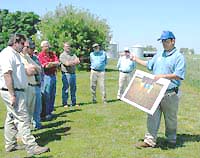Technology Uses Plant Color to Determine Fertilizer Need
Technology Uses Plant Color to Determine Fertilizer Need

University of Kentucky College of Agriculture agronomists are testing technology that uses the color of wheat to determine fertilizer need to see if it will help the state’s farmers.
The technology uses sensors to measure spectral reflectance of red and near-infrared colors from the crop canopy to determine nutrient needs. The determination is made as the applicator travels through the field. Called GreenSeeker, the process was developed by Oklahoma State University and is now commercially available.
Using a series of nozzles, a sprayer system can apply differing rates every 6 square feet at a speed of 15 miles per hour.
UK agronomists are using algorithms (mathematical formulas) developed in Oklahoma and Virginia to control fertilizer rates based on plant color. In addition, UK is also working to develop an algorithm that would be best for use in Kentucky fields, said Greg Schwab, UK Extension plant and soil scientist. Those are compared to flat rates traditionally used by farmers in terms of overall yield and profit. The research is being funded through a precision agriculture grant from the U.S. Department of Agriculture.
UK’s work with the technology began with the 2003-04 wheat crop and continues this year. Schwab highlighted the work and showed farmers some of this year’s test plots during the annual UK Wheat Science field day.
With only one year’s data collected, he said, no firm recommendations have been developed. However, he is optimistic it will work.
“The results indicate the GreenSeeker technology can aid in nitrogen management decisions by giving farmers the confidence they need to decrease their overall nitrogen application,” Schwab said.
The technology is costly but, as with most new advances, will likely come down in the years ahead. Schwab said rather than wait until farmers are using the technology to determine its best use in Kentucky; he and other scientists hope to be able to have the information already in hand when farmers begin using it.